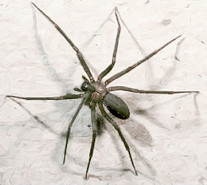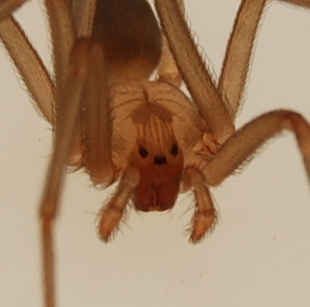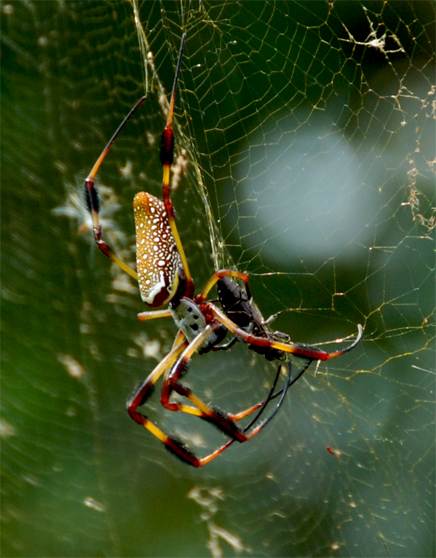|
Loxoscelism
Loxoscelism () is a condition occasionally produced by the bite of the recluse spiders (genus ''Loxosceles''). The area becomes dusky and a shallow open sore forms as the skin around the bite dies (necrosis). It is the only proven type of necrotic arachnidism in humans. While there is no known therapy effective for loxoscelism, there has been research on antibiotics, surgical timing, hyperbaric oxygen, potential antivenoms and vaccines. Because of the number of diseases that may mimic loxoscelism, it is frequently misdiagnosed by physicians. Loxoscelism was first described in the United States in 1879 in Tennessee. Although there are up to 13 different ''Loxosceles'' species in North America (11 native and two nonnative), ''Loxosceles reclusa'' is the species most often involved in serious envenomation. ''L. reclusa'' has a limited habitat that includes the Southeast United States. In South America, '' L. laeta'', '' L. intermedia'' (found in Brazil and Argentina), and '' L. ga ... [...More Info...] [...Related Items...] OR: [Wikipedia] [Google] [Baidu] |
Loxosceles Laeta
The Chilean recluse spider, ''Loxosceles laeta'', is a highly venomous spider of the family Sicariidae. In Spanish, it (and other South American recluse spiders) is known as ', or "corner spider"; in Brazilian Portuguese, as ' or "brown spider". It is considered by many to be the most dangerous of recluse spiders, and its bites often result in serious systemic reactions, up to and including death. Description The Chilean recluse is one of the larger species of recluse spiders, generally ranging from 8–40 mm in size (including legs). Like most recluses, it is brown and usually has markings on the dorsal side of its thorax, with a black line coming from it that looks like a violin with the neck of the violin pointing to the rear of the spider resulting in the nickname "fiddleback spider" or "violin spider" in English-speaking areas. Coloring varies from light tan to brown and the violin marking may not be visible. Since the "violin pattern" is not diagnostic, it is far mo ... [...More Info...] [...Related Items...] OR: [Wikipedia] [Google] [Baidu] |
Loxosceles Reclusa
The brown recluse (''Loxosceles reclusa''), Sicariidae (formerly placed in a family "Loxoscelidae") is a recluse spider with Necrosis, necrotic venom. Similar to those of other recluse spiders, their bites sometimes require medical attention. The brown recluse is one of three spiders in North America with list of medically significant spider bites, medically significant venom, the others being the Latrodectus, black widow and the Loxosceles laeta, Chilean recluse. Brown recluse spiders are usually between , but may grow larger. While typically light to medium brown, they range in color from whitish to dark brown or blackish gray. The cephalothorax and abdomen are not necessarily the same color. These spiders usually have markings on the Dorsum (biology), dorsal side of their cephalothorax, with a black line coming from it that looks like a violin with the neck of the violin pointing to the rear of the spider, resulting in the nicknames fiddleback spider, brown fiddler, or violin ... [...More Info...] [...Related Items...] OR: [Wikipedia] [Google] [Baidu] |
Brown Recluse Spider
The brown recluse (''Loxosceles reclusa''), Sicariidae (formerly placed in a family "Loxoscelidae") is a recluse spider with necrotic venom. Similar to those of other recluse spiders, their bites sometimes require medical attention. The brown recluse is one of three spiders in North America with medically significant venom, the others being the black widow and the Chilean recluse. Brown recluse spiders are usually between , but may grow larger. While typically light to medium brown, they range in color from whitish to dark brown or blackish gray. The cephalothorax and abdomen are not necessarily the same color. These spiders usually have markings on the dorsal side of their cephalothorax, with a black line coming from it that looks like a violin with the neck of the violin pointing to the rear of the spider, resulting in the nicknames fiddleback spider, brown fiddler, or violin spider. Description The violin pattern is not a definitive identifier, as other spiders can have ... [...More Info...] [...Related Items...] OR: [Wikipedia] [Google] [Baidu] |
Loxosceles Gaucho
''Loxosceles gaucho'' commonly known in English as the gaucho spider. is a highly venomous recluse spider endemic to South America. Description and behavior Adult females grow up to 7–12 mm, the maximum reported is 14 mm. They are mainly characterized by their brown color, leading to them be colloquially referred to as ''''Aranha marrom'''' (Portuguese for brown spider) in Brazil, the body is characterized by a pale to dark brown color (often reddish), with a dorsal violin-shaped mark, slightly darker on the carapace, with long and slender legs, without dark marks or stripes. Males have the thoracic region with the clearest impression, consisting of bands, with the anterior portion of the cephalothorax forming in the rear direction a '' V '' design, while pedipalps have the last short articles and curved stylus. Females have the anterior portion of the cephalothorax forming a '' U '' shape backwards. Like many recluse spiders, It is nocturnal, hunting preys such as i ... [...More Info...] [...Related Items...] OR: [Wikipedia] [Google] [Baidu] |
Spider Bite
A spider bite, also known as arachnidism, is an injury resulting from the bite of a spider. The effects of most bites are not serious. Most bites result in mild symptoms around the area of the bite. Rarely they may produce a necrotic skin wound or severe pain. Most spiders do not cause bites that are of importance. For a bite to be significant, substantial envenomation is required. Bites from the widow spiders involve a neurotoxic venom which produces a condition known as latrodectism. Symptoms may include pain which may be at the bite or involve the chest and abdomen, sweating, muscle cramps and vomiting among others. Bites from the recluse spiders cause the condition loxoscelism, in which local necrosis of the surrounding skin and widespread breakdown of red blood cells may occur. Headaches, vomiting and a mild fever may also occur. Other spiders that can cause significant bites include the Australian funnel-web spider and South American wandering spider. Efforts to preve ... [...More Info...] [...Related Items...] OR: [Wikipedia] [Google] [Baidu] |
Spider Bite
A spider bite, also known as arachnidism, is an injury resulting from the bite of a spider. The effects of most bites are not serious. Most bites result in mild symptoms around the area of the bite. Rarely they may produce a necrotic skin wound or severe pain. Most spiders do not cause bites that are of importance. For a bite to be significant, substantial envenomation is required. Bites from the widow spiders involve a neurotoxic venom which produces a condition known as latrodectism. Symptoms may include pain which may be at the bite or involve the chest and abdomen, sweating, muscle cramps and vomiting among others. Bites from the recluse spiders cause the condition loxoscelism, in which local necrosis of the surrounding skin and widespread breakdown of red blood cells may occur. Headaches, vomiting and a mild fever may also occur. Other spiders that can cause significant bites include the Australian funnel-web spider and South American wandering spider. Efforts to preve ... [...More Info...] [...Related Items...] OR: [Wikipedia] [Google] [Baidu] |
Recluse Spider
The recluse spiders (''Loxosceles'' (), also known as brown spiders, fiddle-backs, violin spiders, and reapers, is a genus of spiders that was first described by R. T. Lowe in 1832. They are venomous spiders known for their bite, which sometimes produces a characteristic set of symptoms known as loxoscelism. Recluse spiders are now identified as members of the family Sicariidae, having formerly been placed in their own family, the Loxoscelidae. Although recluse spiders are feared, they are usually not aggressive. Relation with other spiders Sicariidae are of the superfamily Scytodoidea. Other families in the Scytodoidea include Drymusidae, Scytodidae, and Periegopidae. Habitat and appearance ''Loxosceles'' is distributed nearly worldwide in warmer areas. All have six eyes arranged in three groups of two (dyads) and some are brownish with a darker brown characteristic violin marking on the cephalothorax. However, the "violin marking" cannot be used as a reliable way to ident ... [...More Info...] [...Related Items...] OR: [Wikipedia] [Google] [Baidu] |
Sicarius (genus)
''Sicarius'' is a genus of recluse spiders that is potentially medically significant to humans. It is one of three genera in its family, all venomous spiders known for a bite that can induce loxoscelism. They live in deserts and arid regions of the Southern Hemisphere, and females use a mixture of sand and silk when producing egg sacs. The name is Latin for assassin. Description ''Sicarius'' spiders can grow up to long, and have six eyes arranged into three groups of two (known as "dyads"). Physically, they resemble crab spiders and members of the '' Homalonychus'' genus. They lack the characteristic violin-shaped marking of the more well-known members of its family, Sicariidae the recluse spiders. They can live for a very long time without food or water. Some can live for up to fifteen years, making them among the longest-lived spiders, behind the trap-door spiders and tarantulas, many known to live for twenty to thirty years. The oldest recorded spider is Number 16, a tra ... [...More Info...] [...Related Items...] OR: [Wikipedia] [Google] [Baidu] |
Loxosceles Intermedia
''Loxosceles intermedia'', the Brazilian brown recluse spider, is a highly venomous spider species in the family Sicariidae native to Brazil and Argentina. Description The male has a total length of 5.3 mm, legs I to IV, have a length of 24.5, 31.8, 20.4 and 23.6 mm, the palp can be 5.4 mm long, females are larger, measuring about 8.5 mm in length, with legs ranging from 15.1, 16.0, 13.1 and 15, 5 mm, the palp of females measures 3.8 mm. Both male and female carapace ranges from dull yellow to orange brown, covered with black and subpretiated bristles. The cephalica pars varies from dark orange-brown to reddish-brown, with a '' U '' shape contrasting with the yellowish pars thoracica. The tubers of the eyes are enlarged, while the lateral marens are not dark, the abdomen is grayish or blackened, with the dorsal part darker than the ventral part, the leg segments vary from orange-brown to reddish-brown. Behavior It is a very shy spider, with noct ... [...More Info...] [...Related Items...] OR: [Wikipedia] [Google] [Baidu] |
Sphingomyelin Phosphodiesterase
Sphingomyelin phosphodiesterase (EC 3.1.4.12, also known as neutral sphingomyelinase, sphingomyelinase, or SMase; systematic name sphingomyelin cholinephosphohydrolase) is a hydrolase enzyme that is involved in sphingolipid metabolism reactions. SMase is a member of the DNase I superfamily of enzymes and is responsible for breaking sphingomyelin (SM) down into phosphocholine and ceramide. The activation of SMase has been suggested as a major route for the production of ceramide in response to cellular stresses. Sphingomyelinase family Five types of SMase have been identified. These are classified according to their cation dependence and pH optima of action and are: * Lysosomal acid SMase * Secreted zinc-dependent acid SMase * Magnesium-dependent neutral SMase * Magnesium-independent neutral SMase * Alkaline SMase Of these, the lysosomal acidic SMase and the magnesium-dependent neutral SMase are considered major candidates for the production of ceramide in the cellular ... [...More Info...] [...Related Items...] OR: [Wikipedia] [Google] [Baidu] |
Arachnologists
Arachnology is the scientific study of arachnids, which comprise spiders and related invertebrates such as scorpions, pseudoscorpions, and harvestmen. Those who study spiders and other arachnids are arachnologists. More narrowly, the study of spiders alone ( order Araneae) is known as araneology. The word "arachnology" derives from Greek , ''arachnē'', "spider"; and , ''-logia'', "the study of a particular subject". Arachnology as a science Arachnologists are primarily responsible for classifying arachnids and studying aspects of their biology. In the popular imagination, they are sometimes referred to as spider experts. Disciplines within arachnology include naming species and determining their evolutionary relationships to one another (taxonomy and systematics), studying how they interact with other members of their species and/or their environment (behavioural ecology), or how they are distributed in different regions and habitats (faunistics). Other arachnologists perform ... [...More Info...] [...Related Items...] OR: [Wikipedia] [Google] [Baidu] |
Myonecrosis
Gas gangrene (also known as clostridial myonecrosis and myonecrosis) is a bacterial infection that produces tissue gas in gangrene. This deadly form of gangrene usually is caused by ''Clostridium perfringens'' bacteria. About 1,000 cases of gas gangrene are reported yearly in the United States. Myonecrosis is a condition of necrotic damage, specific to muscle tissue. It is often seen in infections with ''C. perfringens'' or any of myriad soil-borne anaerobic bacteria. Bacteria cause myonecrosis by specific exotoxins. These microorganisms are opportunistic and, in general, enter the body through significant skin breakage. Gangrenous infection by soil-borne bacteria was common in the combat injuries of soldiers well into the 20th century, because of non-sterile field surgery and the basic nature of care for severe projectile wounds. Other causes of myonecrosis include envenomation by snakes of the genus ''Bothrops'' (family Viperidae), ischemic necrosis, caused by vascular blockage ... [...More Info...] [...Related Items...] OR: [Wikipedia] [Google] [Baidu] |





